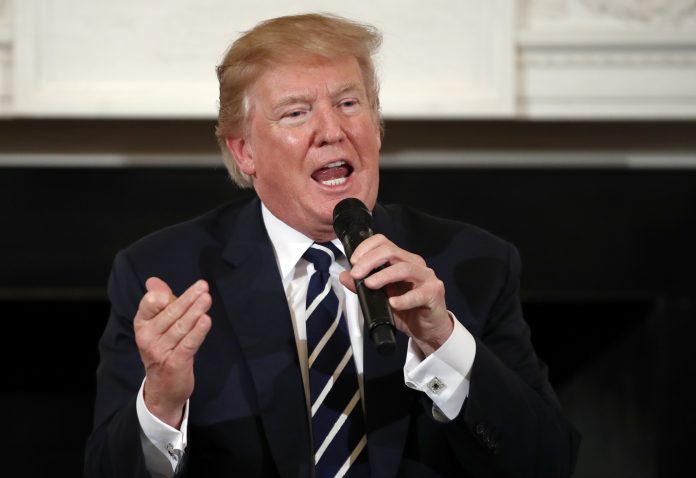
Alexis Arnold says she’s sympathetic toward protesters who have peacefully fought racial injustice this summer. But as some demonstrations spiral into violence, her anxiety is building.
“Why are we so broken right now?” the 44-year-old art gallery owner wondered.
The uncertainty is drawing her to whatever stability President Donald Trump can offer. He has spent weeks pushing questions of safety and security to the forefront of the presidential campaign. And there are signs some Wisconsin voters are listening, after protests have sometimes become violent in Kenosha, Wisconsin, where a white police officer shot a Black man, Jacob Blake, seven times, paralyzing him.
“The public just needs something to make them feel comfortable and safe again,” said Arnold, who is white, has voted for Democrats in the past and is raising a biracial daughter. “I almost rather see Trump stay and try to resolve it rather than bring somebody in new.”
That sentiment could prove decisive in Wisconsin, a state that put Trump in the White House in 2016 after he carried it by less than 1 percentage point. The president has already used dark and misleading warnings of destruction in American streets following violence in Portland, Oregon, and is now seizing on unrest in Kenosha, where he’ll travel on Tuesday.
Read more at NEWSMAX.
{Matzav.com}












“…dark and misleading warnings of destruction in American streets…” What was misleading about those warnings? This is straight out of the “Protocols of the Elders of Zion” playbook.
I particularly like the line about “…where the protests have sometimes become violent…”. Like about 100% of the time. But then, these are the people who say that Palestinian terrorists are mostly peaceful.
According to Stuart Stevens, No, Wisconsin won’t make Democrats lose
Stuart Stevens is a senior adviser to the Lincoln Project and author of “It Was All A Lie: How the Republican Party Became Donald Trump.”
Open your window and you can hear the nervous chatter of Democrats across the country worried that the images of civil unrest in Wisconsin will tilt the election toward President Trump. “This is how Democrats lose” is the gist of the lead in a number of articles. I have a different view.
Look at the numbers: Trump won the presidency in 2016 with 46.1 percent of the electorate; Mitt Romney lost with 47.2 percent. What was the difference? An increase in third party voting — that’s not happening this year — and a decline for the first time in 20 years in non-White turnout. It makes for a pretty simple equation: If non-White turnout continues to decline, Joe Biden probably can’t win. If non-White turnout returns to a level of the previous three presidential elections, it’s hard for him to lose.
You can call what is happening in Wisconsin and elsewhere protests, which they are, but they are also get-out-the-vote rallies for the Black community. In 2012, Romney lost Wisconsin by 7 percentage points; Trump won by just less than 1 percentage point. But Romney got more votes. What was the difference? Forty thousand fewer voters showed up in the greater Milwaukee area. Does anyone really think that if the election were held on Tuesday that African American turnout would not hit record levels?
Trump started a cultural war when he took office and, like his trade war, he lost it. Not long ago he was in Alabama campaigning for Sen. Luther Strange in the special election to replace Jeff Sessions and attacking NFL players who took a knee. “Get that son of a bitch off the field,” Trump bellowed. Now entire teams of professional basketball and baseball players (and other athletes in other sports) are refusing to play in solidarity with Black Lives Matter. After my home state of Mississippi pulled down the state flag featuring the Confederate battle flag, Trump found himself attacking NASCAR for banning the Confederate flag. A Republican president on the wrong side of a cultural war with NASCAR?
Trump is betting that it’s still 1968 in the United States, and in a narrow way he isn’t wrong. But his problem is that he’s the incumbent, the Lyndon Johnson to Joe Biden’s Richard Nixon, whose campaign slogan was, “Bring us together.” In the latest post-Republican National Convention Morning Consult poll, only 32 percent believe the country will be safer if Trump wins vs. 43 percent who think it will be less safe. Fifty-two percent think Trump’s reelection will lead to more violence while only 25 percent think it will lead to less violence. While 27 percent say, “Trump will protect us from the chaos,” 46 percent believe “Trump is the source of the chaos.
Who’s the radical in the race? By a margin of 13 points, voters view Trump as more radical than Biden (34 percent to 21 percent.) Who would handle protests better? Voters prefer Biden 43 percent to 35 percent.
In short, Trump is losing $5 on every sale and hoping to make it up on volume.
Trump’s basic problem is that he doesn’t understand how America has changed. Women who live in the suburbs don’t think of themselves as “suburban housewives.” Your average White teenager in the South looks to Black rap stars as cultural icons more than to Robert E. Lee. Americans who live in the suburbs don’t want to think of themselves as afraid of diversity in their neighborhoods. They want their children to see them as role models who would welcome new neighbors from a different ethnic or religious background.
Nothing in our culture from sports to music to television to films paints a positive view of bigotry and hate. Only in isolated corners of the digital universe do the haters and racists find others who reinforce their anger and bitterness.
I’ve worked in five Republican presidential contests including the 2004 reelection campaign of George W. Bush, the only Republican to win the popular vote in the past 32 years. Watching the Democratic convention, I felt like a football coach seeing a team focused on fundamentals. Politics will always be about addition and not subtraction. From John Kasich to Bernie Sanders, we saw old-fashioned coalition building. Republicans were like a team coached by a star player who was determined that every play depend on his ability to execute. It was vain, self-indulgent and ineffective.
We will soon be in the campaign stretch, when odds are good that the problems most troubling Americans will revolve around the economy and the disruption created by a failed covid-19 response. Kids who went away to college this month will likely be back at home when their campuses have reverted to all-remote learning. Schools that do open for in-class sessions will likely be closing or are soon to close, with parents watching their kids’ anxiety rise while their education suffers. There will be far fewer Friday night lights this fall, and family reunions at Thanksgiving and at holidays that follow look to be extra-complicated, both if you need to travel and then once you and yours finally get together.
The fabric of American life has been torn and the calming presence of a man who actually knows how to be president will be far more appealing than a red-faced screamer furious at what has happened on his watch.